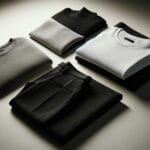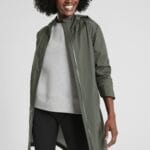Get ready to upgrade your jacket game! Cinching is the secret weapon to transforming any jacket into a flattering masterpiece that complements your curves and brings out your best style. In this easy-to-follow guide, we’ll share step-by-step secrets on how to cinch your jacket like a pro, so you can rock that confident and polished look every time you step out the door.
Cinch Every Body Type
Let’s be real, finding clothes that fit just right can feel like winning the lottery sometimes. But guess what? You can have that winning feeling every day, and a cinched jacket might just be your secret weapon!
Think of it like this: cinching is like a magic trick that highlights your natural shape. It’s all about creating that hourglass silhouette, even if you feel like you don’t naturally have one. The best part? It works for every body type!
First Things First: Picking the Perfect Jacket
Before you start cinching, you need the right jacket to work with. Here’s the inside scoop:
- Body Type: This plays a big role. Pear shapes, you already know you rock a killer waist-to-hip ratio, and cinching just makes it even more amazing. If you’re more of an apple shape, try cinching a little lower down to create some curves. And hourglass figures? You lucky things can pull off any style!
- Fabric: Think about the season and the occasion. Lightweight fabrics like cotton are your best friend in summer, while cozy wool will keep you warm when it’s chilly.
- Style: Your jacket, your rules! A tailored blazer adds instant polish to any outfit, while a sporty zip-up is perfect for a more relaxed vibe.
Time for the Transformation: Cinch It Up!
Now for the fun part:
- Tailoring is Your Friend: Okay, this one might cost a few extra bucks, but trust me, it’s worth it. Getting your jacket tailored is like having a superpower – it creates a custom cinch that fits you perfectly.
- Belts: The Quick Fix: Want a faster (and often cheaper) option? Belts are your new best friend. A cute belt can instantly cinch your waist. Pro tip: Choose a belt that complements your jacket’s style and color.
- Built-In Magic: Keep an eye out for jackets with built-in drawstrings or adjustable waists. They’re basically like having a cinch on demand—easy peasy!
Level Up Your Look: Styling a Cinched Jacket
Now that you’ve got the cinching down, let’s talk about making it your own.
- Dress to Impress: A cinched blazer paired with some sleek pants or a skirt? Talk about instant sophistication!
- Keep it Casual: Don’t think cinching is just for fancy occasions. You can totally rock a cinched jacket with your favorite jeans and a comfy tee for a casual-cool look.
- Versatility is Key: That’s the beauty of a cinched jacket – you can dress it up or down. From a night out with friends to a busy day running errands, it just works.
Extra Tips for Extra Fabulousness:
- Proportion is Everything: Balance is key. If you’re rocking a cinched jacket, try pairing it with slightly wider-leg pants or a flowy skirt.
- Accessorize, Accessorize, Accessorize: Don’t be afraid to have fun with it! Scarves, jewelry, or even a statement belt buckle can all draw attention to your waist and make your outfit pop.
- Embrace Those Curves: Remember, everyone is beautiful in their own way! A cinched jacket is all about celebrating your curves and feeling confident in your own skin.
So there you have it! With these tips and a little bit of confidence, you’ll be rocking that cinched look like a true fashion icon. Now go out there and own it!
What is a Bungee Jacket?
We’ve talked about what makes certain jackets stand out, but now let’s dive into a style that’s all about practicality and a touch of cool: the bungee jacket. While not technically a distinct category like “bomber jackets” or “trench coats,” the term “bungee jacket” is gaining traction, particularly in online searches. This suggests a growing interest in jackets featuring this versatile design element.
Defining the Bungee Jacket
So, what exactly defines a bungee jacket? The most prominent feature, as the name suggests, is the incorporation of bungee cords, typically located at the waist. These cords act like an internal or external belt, allowing for on-the-fly adjustments to the jacket’s fit. However, it’s important to note that not all jackets with a cinched waist can be classified as “bungee jackets.” A true bungee jacket utilizes the unique properties of bungee cords, known for their elasticity and adjustability.
Why Choose a Bungee Jacket?
Bungee jackets offer several advantages that contribute to their rising popularity:
Customizable Fit: This is arguably the most significant benefit. Unlike traditional jackets with a fixed waistline, bungee jackets empower the wearer to fine-tune the fit according to their preference and comfort level. Need a more relaxed fit for layering over a bulky sweater? Simply loosen the bungee cord. Desire a more streamlined silhouette? Cinch it in for a snugger fit. This adaptability makes them ideal for fluctuating temperatures and layering needs.
Enhanced Layering: Speaking of layering, bungee jackets excel in this department. Thanks to their adjustable fit, they can accommodate various layers underneath without feeling restrictive. This is particularly beneficial in transitional weather when you might need to shed or add layers throughout the day.
Convenient Storage: While not always a primary function, the external bungee cords on some jackets can double as a handy storage solution. Need to secure a light scarf, gloves, or even a small map on the go? The bungee cords provide a quick and easy way to keep these items within reach.
Style and Versatility: Bungee jackets come in a variety of styles, from sleek urban designs to more rugged outdoor-inspired options. This makes them incredibly versatile, capable of seamlessly transitioning from city streets to hiking trails, all while maintaining an air of effortless cool.
Bungee Jackets in Action
Let’s take a look at some examples of how bungee jackets are making their mark:
The Jazzercise Essential: This jacket highlights the fusion of style and function that bungee jackets offer. Marketed as a layering piece for dance fitness enthusiasts, it features bungee details at the waist for a flattering, customizable fit.
Technical Outdoor Wear: Brands like Mountain Equipment utilize hidden bungee systems in jackets like the Lhotse. These internal adjustments allow for a streamlined look while still offering a secure, customizable fit.
Separating the Myths: Bungee Jackets vs. Paddle Jackets
One common point of confusion surrounding bungee jackets is their relationship to “paddle jackets.” While both often feature bungee cords, it’s essential to distinguish between them.
Paddle jackets, as the name suggests, are specifically designed for kayaking and other watersports. They typically feature a waterproof breathable membrane and often utilize bungee cords at the waist and cuffs to create a tight seal against water ingress. While kayakers might appreciate the adjustability of a bungee jacket, they are not considered ideal paddling attire due to their lack of specialized waterproof features.
Beyond Jackets: Bungee Cords in Backpacks
While our focus is on bungee jackets, it’s worth noting that the versatility of bungee cords extends beyond outerwear. Backpacks, particularly those designed for hiking and outdoor adventures, often incorporate bungee cord systems for expanding storage capacity. These cords allow you to securely attach additional gear to the exterior of the backpack, providing a convenient solution for items that don’t fit inside or need to be readily accessible.
The Future of Bungee Jackets
As with any fashion trend, the future of bungee jackets is constantly evolving. One exciting area of development is the incorporation of sustainable materials and manufacturing practices. Consumers are increasingly seeking eco-friendly options, and bungee jackets made from recycled fabrics or organic cotton are becoming more readily available.
Another potential avenue for innovation lies in the realm of high-tech adjustments. Imagine a bungee jacket with electronically controlled tension settings, allowing you to fine-tune the fit with the touch of a button. While such concepts might seem futuristic, the rapid pace of technological advancement in the apparel industry suggests that these possibilities might not be too far off.
In conclusion, the bungee jacket, while often overlooked, represents a compelling blend of style, functionality, and adaptability. From its customizable fit and enhanced layering capabilities to its convenient storage solutions and versatile aesthetics, the bungee jacket has carved out a unique space in the world of outerwear. As designers continue to experiment with new materials, technologies, and design elements, it will be exciting to see how the bungee jacket continues to evolve and capture the imagination of fashion-forward individuals and outdoor enthusiasts alike.
What is a Belay Jacket?
From cinched waists to specialized gear, let’s shift our focus to a jacket designed for warmth in challenging conditions: the belay jacket. Picture this: you’re several hundred feet up a rock face, the wind is biting, and your partner needs you focused as they navigate the next pitch. Enter the belay jacket – your cozy, protective ally against the elements.
Understanding the Basics
A belay jacket, in essence, is a highly insulated jacket built for warmth during periods of inactivity in cold outdoor environments. While initially popularized by climbers (belaying refers to the act of securing a climbing rope for your partner), these jackets have transcended their climbing-specific origins to become a staple for anyone braving the cold for extended periods.
Why a Belay Jacket?
You might be wondering: “Can’t I just layer up with a regular jacket?” While layering is crucial, a belay jacket serves a more specialized purpose:
Intensified Warmth: Belay jackets are engineered for exceptional warmth, often surpassing the insulation levels of typical winter jackets. This is crucial when you’re stationary, as your body generates less heat compared to when you’re actively moving.
Weather Resistance: Many belay jackets are constructed with weather-resistant materials, incorporating features like Durable Water Repellent (DWR) coatings and windproof fabrics. These features provide an additional layer of protection against unexpected precipitation and wind chill, keeping you dry and comfortable.
Comfort and Mobility: While prioritizing warmth, belay jackets are also designed for comfort and freedom of movement. This is essential for climbers who need to maintain dexterity while belaying but also translates to other activities like hiking or camping, where ease of movement is crucial.
Types of Belay Jackets
Belay jackets generally fall into two main categories, each catering to different needs and conditions:
Lightweight Belay Jackets: Ideal for milder temperatures or when packability is a priority. These jackets often utilize synthetic insulation, renowned for its warmth-to-weight ratio and ability to retain heat even when wet. Lightweight belay jackets are available in various styles, from simple zip-ups to cozy pullovers.
Expedition/Heavyweight Belay Jackets: As the name suggests, these jackets are the heavy hitters in the belay world, designed to combat extreme cold and harsh conditions. They typically feature high-loft down insulation, prized for its exceptional warmth. Expedition belay jackets often boast additional features like helmet-compatible hoods, spacious pockets for essentials, and robust outer shells built to withstand rugged terrain.
Choosing Your Perfect Belay Jacket
With an array of options available, selecting the right belay jacket can feel overwhelming. Here’s a breakdown to guide your decision:
Adventure Awaits: What activities will you be using the jacket for? Scaling icy mountains will demand different features than a leisurely winter hike.
Embrace the Elements: Consider the typical weather conditions you’ll encounter. Are you braving sub-zero temperatures and howling winds, or are milder conditions the norm?
Budgetary Considerations: Belay jackets span a wide price range influenced by factors like insulation type, features, and brand reputation. Setting a budget beforehand can help narrow down your options.
Key Features to Consider
Insulation: Down remains the gold standard for warmth, but advancements in synthetic insulation offer compelling alternatives, often with improved moisture management and packability. Look for fill power ratings (for down) or gram weights (for synthetic) to gauge warmth levels.
Warmth-to-Weight Ratio: Especially important for backpacking or activities where packability is crucial. Lightweight materials and efficient insulation designs are key.
Weather Resistance: Look for jackets with DWR coatings and tightly woven fabrics to repel water and block wind.
Fit: A good belay jacket should fit comfortably over other layers without restricting movement. Articulated elbows and adjustable hems enhance mobility.
Features: Helmet-compatible hoods, two-way zippers for ventilation, internal pockets for electronics, and reinforced shoulders for durability are just a few features to consider.
The History and Evolution of Belay Jackets
The concept of a specialized jacket for staying warm during belaying emerged in the 1970s and 80s alongside the evolution of technical climbing. Early belay jackets were often basic, utilizing synthetic insulation and simple designs.
Patagonia’s iconic DAS Parka, released in the late 1980s, marked a turning point. This revolutionary jacket, with its then-groundbreaking use of high-loft fleece, popularized the term “belay jacket” and set a new standard for warmth and functionality.
Over the years, belay jackets have undergone significant advancements. Lighter-weight materials, higher-performance insulation (both down and synthetic), and technical features have elevated their performance and comfort.
The Belay Jacket in a Layering System
It’s important to understand that a belay jacket functions as part of a broader layering system for outdoor activities. The “action suit” concept, popularized in the 1980s, emphasizes a combination of breathable base layers, insulating mid-layers worn during periods of activity, and a highly insulated outer layer (the belay jacket) for warmth when stationary.
Beyond Climbing: The Versatility of Belay Jackets
While rooted in climbing, the practicality of belay jackets has earned them a place in various cold-weather pursuits. Hikers, campers, skiers, and even those braving frigid commutes have embraced the warmth and comfort these jackets provide.
The Future of Warmth
The world of belay jackets continues to evolve, driven by innovations in insulation technology and a growing emphasis on sustainability.
Sustainable Solutions: Many outdoor brands are prioritizing recycled materials, such as recycled polyester insulation and ethically sourced down. These initiatives minimize environmental impact without compromising performance.
Cutting-Edge Technologies: From new insulation types like graphene aerogel, known for its exceptional warmth-to-weight ratio, to jackets with integrated heating elements, the future of staying warm is brimming with possibilities.
In conclusion, the belay jacket, born from the demands of climbing, has become a symbol of warmth, comfort, and preparedness in challenging conditions. By understanding the different types, key features, and the evolution of this specialized garment, you’ll be well-equipped to choose the perfect belay jacket to keep you cozy and protected on your next adventure, whether it’s scaling a mountain or navigating a winter wonderland.
What are the folds on a jacket called?
We’ve discussed cinching and specialized jackets, but now let’s break down a fundamental element of jacket design: those folded flaps of fabric on the front that run from the collar to the buttons. You see them everywhere, adding a touch of polish and shaping the overall look of a jacket. These, my friends, are called lapels.
More Than Just Folds: The Significance of Lapels
While often overlooked, lapels play a crucial role in a jacket’s overall aesthetic and functionality.
Style Statement: Lapels are a defining design feature that dramatically impacts a jacket’s formality, silhouette, and personality. Think of them as the tailored equivalent of a good haircut – they frame your face and contribute significantly to first impressions.
Fit Fundamentals: The width and style of the lapels influence how a jacket sits on the body. Wider lapels can create an illusion of broader shoulders, while slimmer lapels offer a more modern and streamlined look. Understanding these nuances can help you choose jackets that flatter your body type and reflect your personal style.
Tailoring Talk: Familiarizing yourself with lapel terminology empowers you to communicate your preferences with tailors effectively. Whether you’re getting a suit fitted or having a jacket altered, knowing the difference between a notch and a peak lapel ensures you achieve your desired look.
A Lapel for Every Occasion: Exploring the Types
Lapels are not one-size-fits-all. They come in various styles, each with its own unique characteristics and connotations:
1. Notch Lapels: The Versatile Favorite
Defining Features: Characterized by a visible “notch” where the lapel meets the collar, forming a stepped shape.
Formality: Considered the most versatile and common lapel style. Notch lapels are at home on a wide range of jackets, from casual blazers and sport coats to more formal suits. In the world of lapels, the notch lapel is the reliable friend, always appropriate and effortlessly adaptable.
2. Peak Lapels: The Statement Maker
Defining Features: Identified by their pointed “peaks” that extend upwards towards the shoulders. The upward direction of the peaks creates a sense of visual strength and formality.
Formality: Peak lapels exude confidence and sophistication. They are typically found on double-breasted jackets, tuxedos, and suits intended for more formal occasions, business settings, or when making a stylish statement.
3. Shawl Lapels: The Epitome of Elegance
Defining Features: Distinguished by a smooth, continuous curve that flows seamlessly from the collar to the button without any notches or breaks. This unbroken line creates an aura of understated elegance.
Formality: Shawl lapels are the epitome of eveningwear sophistication. They are most commonly found on tuxedos and dinner jackets, adding a touch of timeless elegance to these formal garments.
Beyond the Basics: Delving Deeper into Lapel Nuances
While understanding the basic lapel types is essential, there’s more to these stylish folds than meets the eye:
Lapel Width: A History in Fashion: The width of lapels has fluctuated throughout history, reflecting changing fashion trends. In the 1970s, wide lapels were all the rage, while the 1980s saw a shift towards slimmer, more streamlined lapels. Today, lapel width continues to evolve, with contemporary styles often favoring slim to mid-width lapels for a modern aesthetic.
The Buttonhole’s Hidden Purpose: Have you ever noticed the small buttonhole on the left lapel of many jackets? This buttonhole, often overlooked, is more than just a decorative detail. It’s a functional element designed to accommodate a boutonnière—a small flower or decorative accessory typically worn on formal occasions.
Lapels and Body Type: A Flattering Combination: Just as with any clothing element, certain lapel styles can complement different body types. For instance, wider lapels can help balance out broader shoulders, while slimmer lapels can create a more elongated silhouette. Experimenting with different lapel styles and widths can help you discover what flatters your body type best.
The Language of Style: Communicating Through Lapels
Lapels are more than just fabric folds; they are subtle yet powerful communicators of personal style and occasion. By understanding the different types, widths, and historical contexts of lapels, you gain a deeper appreciation for the nuances of tailoring and the impact even the smallest details can have on your overall look.
So, the next time you slip on a jacket, take a moment to appreciate the artistry of the lapels. These often-overlooked details play a crucial role in shaping the garment’s aesthetic and your personal style statement. And who knows, you might just surprise yourself with your newfound knowledge of lapel terminology the next time you find yourself in conversation with a tailor.
In the winter months, warm your feet up with the brookstone foot massager to help soothe away aches and pains. To get started with your journey to clear skin, be sure to sign up for the clearskinstudy email address.
- China II Review: Delicious Food & Speedy Service - April 17, 2025
- Understand Virginia’s Flag: History & Debate - April 17, 2025
- Explore Long Island’s Map: Unique Regions & Insights - April 17, 2025















